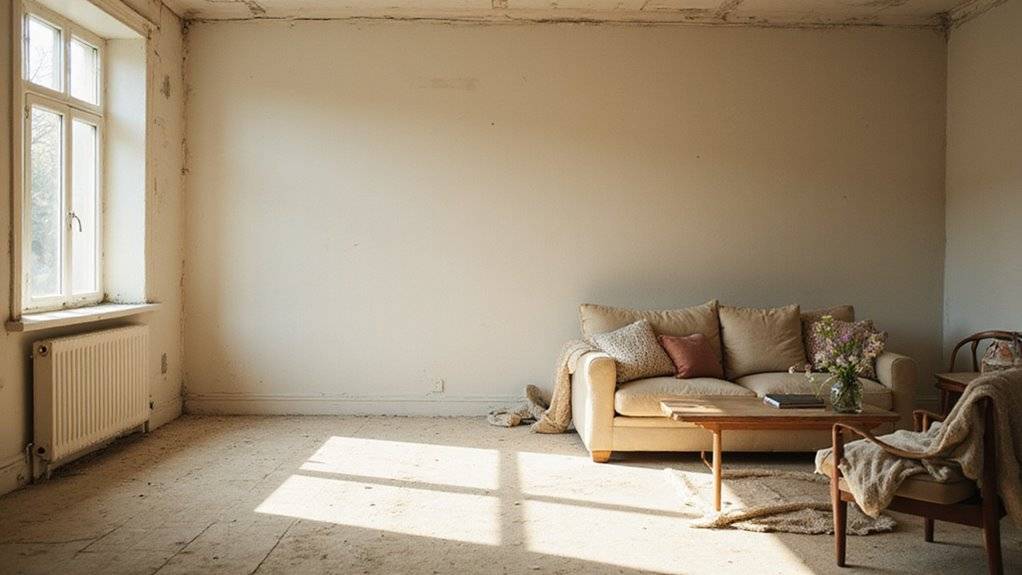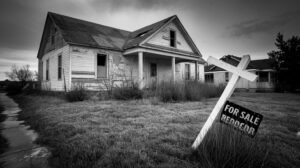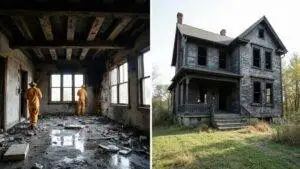Selling a vacant home is not the same as selling one that’s lived in. Empty rooms can feel cold and uninviting, making it hard for buyers to see the home’s potential. Sellers often underestimate how much an empty house can hurt their chances.
Buyers may struggle to picture their lives in a vacant home. They might worry about hidden problems or lack of maintenance. These fears can lower offers or keep buyers away.
Selling a vacant home is different because it requires extra care, creative staging, and strong marketing to attract buyers.
Smart sellers use proven strategies to make their property stand out. With the right steps, you can overcome the challenges of selling an empty house. This blog will guide you through solutions to make selling your vacant home easier and more successful.
Key Takeaways
- Vacant homes lack furniture, making it harder for buyers to visualize living in the space or emotionally connect to the property.
- Vacant properties are at higher risk for unnoticed maintenance issues, vandalism, and security concerns compared to occupied homes.
- Buyers often perceive vacant homes as quick-sale opportunities, which can result in lower offers and more price reductions.
- Staging and presentation are more challenging for vacant homes, requiring extra effort or virtual staging to showcase the home’s potential.
- Occupied homes appear better maintained and lived-in, increasing buyer confidence and often leading to faster, higher offers.
Buyer Perception of Space and Potential
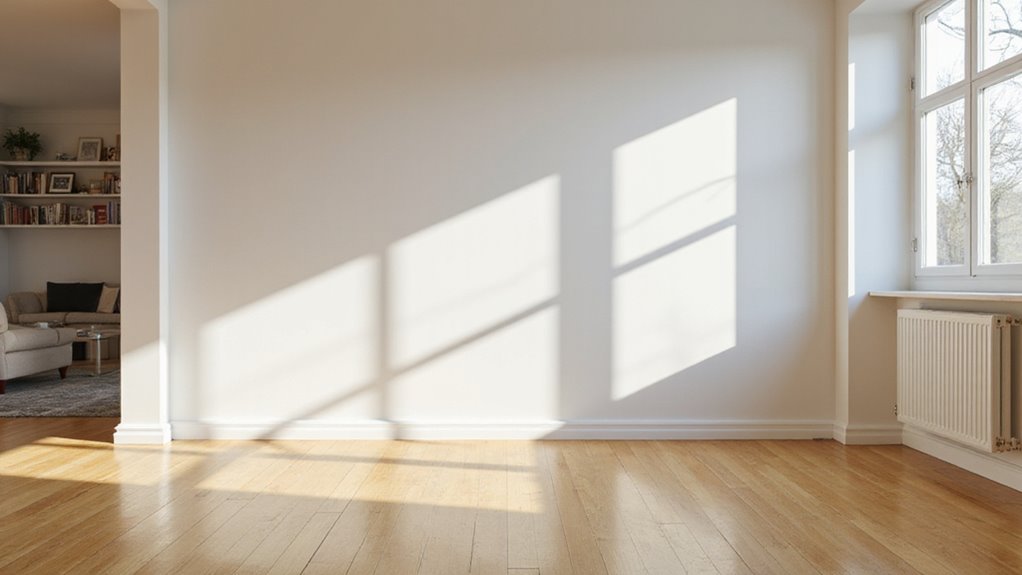
Buyers see a home’s space differently when it is vacant or occupied. A vacant home shows bare rooms, which can make it hard to judge size. If the space looks empty, some buyers may find it hard to picture their furniture there. Buyers who are interested in fair cash offers may also be less concerned with aesthetics and more focused on the property’s structure and potential.
Occupied homes have furniture that gives clues about how to use each room. Furniture helps buyers imagine how their own things might fit. If a home is well-arranged, buyers may feel more connected to the space.
If buyers cannot see how they would live in the home, they may lose interest. Clear layouts and good staging can help buyers see a home’s full potential. A buyer’s decision often depends on how easily they can picture themselves living in the space. Buyers are also influenced by whether the property is being sold as-is in its current condition, as this can impact their perception of the home’s potential and the amount of work required after purchase.
Impact on Home Staging Strategies
Staging strategies change depending on whether a home is vacant or occupied. Each situation has its own challenges and benefits. Adjusting your approach for each type can help a home sell faster.
Staging a home requires different strategies for vacant and occupied spaces, each with unique challenges and benefits for a successful sale.
A vacant home needs furniture and decor to show how each room could be used. Staging helps buyers imagine living there. If rooms look empty, buyers may struggle to see the home’s full potential. For sellers who want a fast, effortless process, working with cash buyers can eliminate the need for staging altogether.
An occupied home must be clean and free of personal items. Using the owner’s existing furniture can work if arranged well. Removing clutter and personal touches helps highlight the home’s features.
If you tailor your staging to the home’s condition, you increase its appeal. Better presentation often leads to better sale results. The right strategy can make a big difference in how quickly a home sells.
Additionally, when selling a home in Florissant, MO, working with cash home buyers can simplify the process whether the property is vacant or occupied, since they purchase homes as-is and eliminate the need for extensive staging or repairs.
Emotional Connection and Buyer Appeal

You want buyers to form an emotional bond the moment they walk in, and strategic staging amplifies that effect. When a home’s furnished, prospects can easily visualize daily routines and lifestyle potential, which drives stronger buyer appeal. Vacant properties, by contrast, often struggle to spark that critical sense of connection.
Selling to local St. Louis experts who buy houses as-is means you can avoid the hassle of traditional showings and still achieve a fair, stress-free sale. Plus, if you choose to sell the Affton house as-is, you can skip the hassle of staging altogether and still attract serious buyers who value simplicity and convenience.
Staging for Emotional Impact
Staging affects how buyers feel about a home. If buyers feel welcome, they may become more interested in the property. Good staging helps buyers picture themselves living there.
Furniture placement can highlight unique features like fireplaces or big windows. Neutral colors make rooms look bigger and more comfortable. If you want buyers to feel relaxed, use soft colors and simple designs.
Sensory touches like fresh flowers can make a home feel warm. Soft fabrics can add comfort and charm. If you want to create a strong impact, use items that appeal to the senses.
Visualization of Daily Living
Occupied homes help buyers imagine their everyday lives more easily. If a home feels lived in, buyers can picture themselves there. This clear vision often makes the property more appealing.
Decorative accents and chosen colors add warmth and connection. Buyers may imagine having coffee in the kitchen or relaxing in a cozy living room. These details can make each space feel inviting.
Strategic furniture placement shows how each area can be used. Clear layouts and subtle décor help buyers understand the purpose of every room. This can lead to faster sales and stronger interest.
| Feature | Vacant Home | Occupied Home |
|---|---|---|
| Buyer Imagination | High demand | Guided by setting |
| Emotional Resonance | Low | High |
| Decorative Accents | Absent | Present |
Challenges With Home Maintenance
Home maintenance can be difficult when selling a house. The condition of a property affects its market value. If a home is not maintained, it may sell for less. Vacant homes are especially at risk of foundation issues because problems like cracks or water damage can go unnoticed for long periods.
Vacant homes need extra attention. Problems like broken lights or pests might go unnoticed if no one lives there. These issues can lower the home’s appeal to buyers.
Vacant homes require special care, as unnoticed issues like pests or broken lights can make them less attractive to buyers.
If the house is occupied, it is easier to spot problems early. Daily living helps catch leaks or other damage right away. Quick repairs can prevent bigger issues.
Three common challenges in vacant homes are easy to overlook. Landscape lighting may stop working, which can make the house look less inviting. Pest problems can grow if no one checks the house often.
General wear and tear also happens faster in empty homes. HVAC systems and plumbing may develop issues from lack of use. Regular checkups are important to prevent costly repairs.
It’s also important for sellers to keep proper documentation of any maintenance or repairs, as this can assist with capital gains tax calculations and provide proof for potential buyers.
Security Concerns for Unoccupied Properties
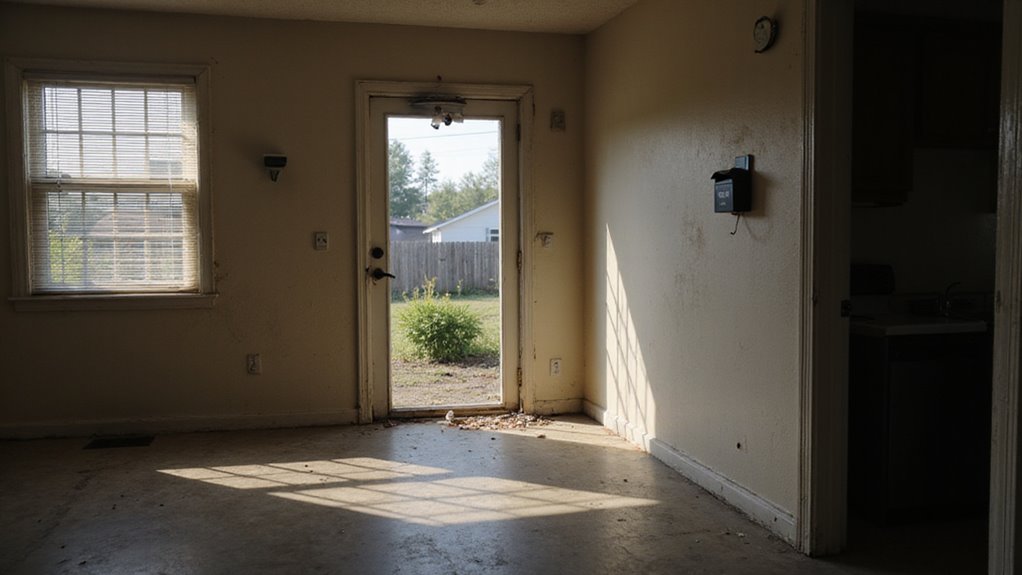
Unoccupied properties face higher security risks because no one is there daily. These homes are easy targets for break-ins, theft, and vandalism. Criminals may notice the lack of activity and try to enter illegally.
Vandals can damage or deface the property, which may lead to expensive repairs. Such damage can also make the home harder to sell. If you want to protect your property, you should take extra precautions. In these situations, it can be helpful to work with home buyers who purchase in any condition, as they understand the unique challenges of selling vacant properties.
Common solutions include installing alarm systems and using smart cameras. Well-lit exteriors can help scare away intruders. If neighbors or professionals check the property often, risk is further reduced.
If you address these issues early, you can protect your investment. Taking action keeps your property safe and attractive. Proper security measures make your home less appealing to criminals.
When selling a vacant home, it is also important to properly disclose any known issues such as asbestos, as failing to do so can result in legal penalties and affect your ability to sell the property.
Influence on Pricing and Negotiation
A property’s occupancy status affects both its market value and your power in negotiations. Vacant homes often seem more available but may also suggest the seller is eager. This can make buyers expect a lower price or better terms.
Buyers usually think vacant homes mean a seller wants a quick sale. If buyers sense urgency, they may offer less or ask for more. This puts pressure on your pricing and negotiation approach. Additionally, vacant homes are often attractive to cash home buyers, who can provide a fast and effortless sale without requiring repairs or cleaning.
You might need to set a competitive price if your property is empty. Doing so can ease concerns about how long it has been on the market. It may also help protect your bottom line.
Occupied homes can discourage buyers from making very low offers. However, if your property is vacant, buyers may feel confident to ask for bigger discounts. If you know this, you can plan your negotiation strategy better.
If you need to sell your house fast, working with a local cash home buyer who understands these dynamics can help you avoid unnecessary discounts and streamline negotiations.
Showing Flexibility and Accessibility

You’ll find that vacant homes offer unmatched flexibility for showings, allowing agents to accommodate prospective buyers on short notice. With immediate access and no need to coordinate around residents’ schedules, you can maximize market exposure and foot traffic.
This streamlined accessibility often shortens days on market and improves buyer interest. Vacant properties also make it easier for reliable buyers to handle everything efficiently, ensuring a convenient and hassle-free selling experience for homeowners. Additionally, owners benefit from no real estate agent fees or commissions, making the process more cost-effective and straightforward.
Easier Scheduling for Showings
A vacant home makes scheduling showings much easier. Agents can show the property quickly without waiting for occupant approval. This can help your home attract more buyers.
Unrestricted access allows agents to book showings at any time. Homes with flexible schedules often spend less time on the market. Properties that are easy to show appear more desirable to buyers.
A lockbox system helps track every entry, which keeps the home secure. Agents and buyers can visit safely, even with frequent access. Security is maintained while maximizing visibility.
Utility management is simpler without daily occupants. If utilities are set at comfortable levels, the home is always ready for showings. This keeps the property in good condition for every visit.
Immediate Buyer Access
Vacant homes allow buyers to visit anytime without scheduling around occupants. This easy access helps buyers tour and inspect the property quickly. It can lead to more showings and faster offers.
Increased access also creates privacy and security risks. Vacant homes are more vulnerable to unauthorized entry or theft. Owners should use security measures like monitored lockboxes and smart systems.
If you provide immediate access and add strong security, your home will stand out. Quick access can speed up the selling process. Proper security ensures your property stays safe while on the market.
No Resident Disruptions
A vacant property means there are no resident disruptions. Showings are easier to schedule because no one lives in the home. Buyers and agents can visit at their convenience.
If there are no residents, showings can happen anytime, even on short notice. This flexibility attracts more buyers and increases property exposure.
Property security is easier to manage when the home is empty. Owners can set up alarms and monitor the property without disturbing anyone.
Utility use is simple to control without residents. If needed, owners can adjust lighting and temperature for showings. This helps save on costs and improve the home’s appeal.
Risks of Wear, Tear, and Vandalism

A vacant home faces greater risks of damage and vandalism. If no one is living there, problems like leaks or broken HVAC systems may go unnoticed. These issues can become expensive and make the property less attractive to buyers.
Vacant homes are also more likely to be targeted by vandals or thieves. Trespassers may break windows, paint graffiti, or steal fixtures. Insurance companies may increase premiums or reduce coverage because of these risks.
If a home is left empty for a long time, it might lose value faster. Buyers may worry about the property’s condition. To prevent problems, owners should consider installing security systems and scheduling regular inspections. Some homeowners choose to sell their house as-is for cash to avoid the ongoing risks and expenses associated with leaving a property vacant.
Curb Appeal and First Impressions
You can’t underestimate the impact of exterior maintenance—it’s your property’s first line of influence on buyers. Strategic landscaping instantly raise perceived value and signals ongoing care. The entryway’s presentation shapes initial buyer expectations, setting the tone for the entire showing experience.
Exterior Maintenance Matters Most
Exterior maintenance is the most important factor for attracting buyers. A well-kept exterior creates a positive first impression. If the outside looks neglected, buyers may lose interest immediately.
Landscaping should always look neat. Trim bushes, mow the lawn, and remove any debris. Clean and organized yards make the property more appealing.
Check all exterior lighting before showings. Working lights make the home safer and highlight its best features. If lights are broken, buyers may think other things are also not maintained.
Repair any visible damage as soon as possible. Fix peeling paint, broken gutters, and cracked driveways. If buyers see repairs are needed, they might delay scheduling a visit.
Good exterior care encourages more people to view the home. Proper maintenance shows owners care for the property. This increases the chance of a quick sale.
Landscaping Sets the Tone
Landscaping gives buyers their first impression of a property. It shows how much care and attention the home has received. Good landscaping can increase interest and perceived value.
A neat garden, trimmed lawn, and working outdoor lights all help a home look inviting. If a home is empty, the outside must feel welcoming and cared for. Each landscaping detail matters more when the inside is bare.
If you improve your landscaping, you may attract more buyers. Adding flowers, pruning shrubs, and lighting paths can make a big difference. Use the table below to check your home’s curb appeal:
| Feature | Impact on Buyers | Enhancement Tips |
|---|---|---|
| Garden Design | Adds visual interest | Use seasonal flowers |
| Outdoor Lighting | Increases safety | Light up paths and doors |
| Lawn Condition | Shows maintenance | Mow and remove weeds |
| Shrubs/Trees | Offers privacy | Prune and shape often |
Entryway Presentation Impact
An entryway shapes a prospect’s view of a property’s value right away. People judge a home within seconds of arrival. If the entry looks unkempt, buyers may believe the rest of the home is too.
Entryway details matter in vacant homes. If you cannot add personal touches, focus on neatness and care. Every small flaw could raise concerns about overall maintenance.
Proper lighting helps the entry feel safe and inviting. Clean surfaces and fresh paint create a polished look. If possible, add simple touches like a plant or clean doormat.
First impressions count. If you improve the entryway, you increase a home’s appeal. A well-kept entry can make the difference in a sale.
Utility Management and Upkeep
Utility management and upkeep are important when selling a home. These tasks depend on whether the home is vacant or occupied. If you do not manage them well, the property may lose value.
A vacant home needs careful monitoring of utilities like electricity and water. Owners should keep heating or cooling on to prevent damage such as mold or pipe issues. Regular check-ins or hiring help is necessary for maintenance.
In an occupied home, the residents usually handle daily upkeep. They mow the lawn, clean gutters, and make small repairs. This ongoing care helps keep the property attractive to buyers.
If you act early and stay organized, you protect your investment. Proper utility management and upkeep help your home sell faster. Potential buyers will also see your property as well-maintained and ready to move in.
Insurance Considerations for Vacant Homes
Vacant homes carry more insurance risks than lived-in homes. Standard homeowners’ insurance may not cover problems that happen when no one lives there. If you plan to leave your home empty for 30 to 60 days, your insurer may call it “vacant.”
Some policies do not cover theft, vandalism, or water damage in empty homes. Insurers may ask for better locks, alarms, or regular checks. If these steps are not met, claims could be denied.
Premiums usually go up for vacant homes. You might need to buy special insurance for this situation. If you want to avoid losses, review your policy and act before leaving the home empty.
Timing and Days on Market
Vacant homes usually stay on the market longer than occupied homes. Buyers may worry about empty houses and possible problems. Occupied homes appear well-cared for, which can attract buyers faster. Vacant homes linger on the market, while occupied homes feel cared for and tend to attract buyers more quickly.
Homes with signs of daily life feel safer and more inviting. If buyers see a property is empty, they may expect lower prices. Sellers of vacant homes often face more price cuts.
If you want a quick sale, keeping the home occupied may help. Occupied homes may also receive better offers. The timing and condition of your listing can directly affect your final sale price.
Professional Photography and Marketing Tactics
You need to utilize professional photography to showcase empty spaces with maximum visual appeal and scale. Virtual staging lets you demonstrate a room’s potential while keeping the focus on architectural details and unique features. By implementing strategic marketing tactics, you’ll capture buyer interest and position your property competitively in the market.
Showcasing Empty Spaces Effectively
Empty homes need special attention to look appealing in photos and listings. These spaces do not have furniture to create warmth or context. Good marketing helps buyers see the home’s best features.
Professional photos are important if the home is empty. Wide-angle lenses make rooms look bigger and more open. Strong, natural lighting can remove shadows and show the home clearly.
Property descriptions should mention unique features, such as new appliances or big windows. Buyers will imagine how they could use the space if these features stand out. Good photos and clear details can help empty homes compete with furnished ones.
Virtual Staging Advantages
Virtual staging makes empty homes look attractive online by adding digital furniture and decorations. This helps buyers imagine living in the space. If you use virtual staging, your property can stand out in online listings.
Virtual staging allows you to show different decorating styles for different buyers. Sellers can highlight a room’s size and layout more clearly with staged photos. High-quality images can boost the home’s perceived value.
If you need to change the décor or room function, virtual staging is easy and affordable. This method is less expensive than traditional staging. It is a smart way to increase buyer interest and improve your listing’s visibility.
Highlighting Unique Property Features
Professional photography is important when showing a home’s unique features. Clear, high-quality images help buyers notice special details. Good photos make your property stand out to potential buyers.
Proper lighting and wide-angle lenses can show off spacious rooms and special finishes. High-resolution images highlight things like custom cabinets and large windows. If buyers see these features clearly, they may be more interested.
If you use virtual tours or videos, buyers can explore the home online. These tools can reveal details that photos might miss. This approach helps attract serious buyers.
Targeted marketing materials, both online and in print, should mention the home’s best features. Ads can point out items like special lighting or great views. If you focus on these highlights, your property may get more attention.
Closing Process and Move-Out Logistics
The closing process and move-out steps depend on whether the home is vacant or occupied. Vacant homes make things easier and faster. Occupied homes add extra steps and possible delays.
Whether a home is vacant or occupied affects closing timelines, with vacant homes allowing for a quicker and simpler process.
A vacant home allows buyers quick access without needing to arrange schedules. Sellers do not have to worry about tenants or last-minute move-outs. The risk of property damage is also lower.
If the home is occupied, the process can slow down. Sellers must handle move-out dates and tenant rights. Buyers may have to wait for the home to be empty.
The final walkthrough in a vacant home is simple. There are no personal items to check. In an occupied home, sellers must confirm the occupant has moved out.
Legal steps are usually simpler with vacant homes. Occupied homes require following tenant laws and respecting their rights. Understanding these points helps make the process smoother.
Conclusion
If you understand the differences between selling a vacant and an occupied home, you can make better decisions. Vacant homes may need more attention, from security to staging, which can raise costs and risks. If you address these issues, you can attract more buyers and sell your home faster.
If you want to avoid the hassle and expenses of preparing a vacant home for sale, you have other options. Some companies, like ours, buy houses for cash in any condition, which can save you time and money. If you sell to a cash buyer, you can skip repairs, staging, and long waiting periods.
If you need to sell your vacant home quickly, we can help. At Freedom Path Investors, we buy houses for cash and handle all the details for you. Contact us today to get a fair offer and move forward with peace of mind.

